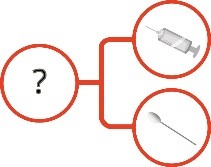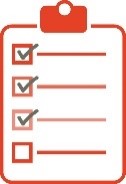Adjust Workflows
Clinicians are juggling a lot at each visit to meet the many medical and psychosocial needs of the patients. Having standardized procedures/workflows that take the clinician out of the picture reliably increases screening, including for HIV.
– Primary care provider
Gather Information and Ideas
As with other areas of change, incorporating universal HIV testing into the clinic workflow is best accomplished by understanding the current process, soliciting ideas for change from those directly involved in that process, and communicating clearly to everyone about the new process.

In addition to early meetings with agency leadership, we followed up site leaders to schedule individual meetings to discuss the overall need to modify workflows. We met with other staff as well to gather initial information about current workflows and collaborate on which test worked best, and where in the workflow it could fit.
It’s important to get input – opinions and recommendations – from staff at all levels, from the front line and up. Any staff who will be affected by testing, anyone who will be asked to change their current workflow, could have ideas on how best to achieve the new goal as easily as possible. Staff can also point out problems that would keep proposed workflows from succeeding. The more often you can get staff to volunteer ideas (“What if we…?), the better your ultimate approach will be. We typically included medical assistants, registered nurses, and/or physicians in these discussions.
In addition, soliciting opinions and ideas from staff encourages their buy-in into the project by creating a sense of ownership. This in turn can increase their personal investment in successfully implementing the new workflow. It’s also important to include supervisors; they may have their own concerns or suggestions and their buy-in is just as crucial.
Information and ideas can be gathered by shadowing current workflows and discussing potential impacts with individual staff, or by brainstorming at staff meetings. For example, we wanted the medical receptionists to hand out HIV testing appointment cards to all patients, so we attended one of their meetings to talk about different ways this new task could be integrated into their workflow.
Customize and Communicate
Chances are small that a single new workflow will suit every department and site. Some customization will be necessary. Here are a few things to keep in mind:
 |
Strive for simplicity. At every level, try to impose as little as possible and minimize the amount of time required. For example, we suggest keeping scripts for patient education extremely simple, only one or two lines long. |
 |
Workflow will vary depending on the type of tests used. Sending patients to the lab to have their blood drawn requires very different steps from taking an oral sample at intake. Rapid testing will require adding a step for patients to receive their results. |
 |
Workflow may also vary depending on patient population. For example, there are additional privacy considerations for when and where to discuss testing with teen patients. |
 |
The more front line staff and medical assistants take on, the easier HIV testing will be for providers who need to deal with immediate health problems during their limited time with patients. Standing orders can empower MA’s to offer and order HIV screening while rooming patients. Also, standing orders become embedded into site protocols and policies, which encourages sustainability. |
 |
Include back up. Make sure staff know whom to turn to if they have questions or run into problems. This gives them confidence to discuss testing with patients because they know if something doesn’t go as expected, there is help available. |
 |
Remember to develop retesting protocols. Which patients should be retested after a previous negative result, and what will that process look like? We decided to offer a retest to high risk patients, such as those with a history of multiple sexually transmitted infections. Also keep in mind the infection window for all tests, especially for patients with possible recent exposure. This is largely a conversation between provider and patient. |
Once you have a plan, then you’ll need to communicate it to staff. We did so primarily at in-person trainings. See the Culture & Knowledge > Understand Workflow Changes & Use EHR Tools section for more on staff training.
Systematize with Policy Updates and EHR Modifications
Once you have a plan for modifying workflows, update your written protocols and policies to incorporate the changes, making site-level modifications as needed. Be sure the EHR is also updated to handle new workflows; without updated EHR templates, workflow change will be very difficult and proper data collection nearly impossible. These structural changes will help integrate testing into your overall systems, contributing to sustainability.
Resources
- Sample workflow flow chart showing routine opt-out testing and review of clinical alerts (.pdf)
- Policy and procedure for routine screening for HIV (.pdf)
- Policy and procedure for Medical Assistants to rooming patients and assess vital signs (.pdf)
- Policy and procedure for rapid HIV fingerstick testing (.docx)
![$logo['alt']](https://srhealth.org/wp-content/uploads/2017/03/srch-logo-1.png)